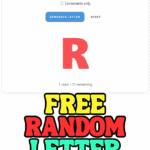Random Letter Generator
We’ve used this simple random letter generator in our homeschool for everything from alphabet games to spelling challenges.
Just click the button to get a letter and try naming animals, foods, or objects that start with it.
Random Letter Generator
Pair the Letter Generator with These Alphabet Activities
The random alphabet selector is a fun starting point, but you can carry that excitement into other activities too. These free printables make it easy to keep practicing letters in playful ways:
- Alphabet Worksheets A–Z – practice tracing, recognition, and letter sounds.
- Alphabet Bingo Game – a fun way to review the alphabet together.
- Alphabet Coloring Pages – creative sheets for each letter.
- Handprint Alphabet Crafts – turn each letter into a keepsake art project.
- Alphabet Scavenger Hunt – get kids moving as they search for letters around the house or classroom.
5 Fun Ways to Use the Alphabet Letter Generator
Once you’ve got the random letter generator ready, there are lots of creative ways to turn it into a game. Here are five simple activities kids love:
Alphabet Bingo or Matching Games
Print or draw simple bingo cards with letters in each square. Spin the generator to call out letters, and kids mark their cards when they hear a match. This works great in small groups or classrooms and helps reinforce letter recognition in a playful way.
Alphabet Scavenger Hunt
Spin a letter and challenge kids to find items around the house or classroom that begin with it. For example, if “B” comes up, they might grab a ball, a book, or a banana. This is an active game that keeps kids moving while connecting letters to real-world objects.
Word Brainstorm Race
Give kids one minute to write down as many words as they can think of that start with the chosen letter. For younger learners, keep it simple with common words, while older kids can stretch their vocabulary by coming up with more unusual examples.
Drawing Challenge
Spin a letter, then ask kids to draw something that begins with it. This combines letter recognition with creativity. If “C” appears, one child might sketch a cat while another chooses a castle. It’s a fun way to mix art into literacy practice.
Story Starter
Spin a letter and have each student start a sentence or short story using a word that begins with it. For instance, if the generator lands on “M,” their story might begin: “My monkey made a mess.” This works well as a group activity, with each person adding a sentence to build a collaborative story.
FAQ About the Random Letter Generator
A single random letter generator (sometimes called an alphabet generator or ABC picker) is a tool that displays one letter of the alphabet at random. It’s often used in classrooms, homeschools, or word games to spark quick activities and help kids practice literacy skills.
You can use it to spark spelling challenges (“name an animal that starts with…”) or scavenger hunts (“find something in the room that begins with…”). It’s also handy for phonics practice, alphabet recognition, or just making learning more playful.
Yes, this generator shows all 26 letters of the alphabet in upper case. For younger children, uppercase letters are easiest to recognize, but you can easily adapt activities to lower case practice too.
Yes, the ABC picker lets you filter so it only generates vowels (a, e, i, o, u) or only consonants. This is helpful when focusing on phonics, word families, or spelling games.
It saves time and makes lessons feel spontaneous. Instead of sorting through flashcards, you can instantly pull a single letter and build a quick activity around it. Teachers and parents often use it for warm-up games, literacy centers, or no-prep learning breaks that still feel purposeful.
The English alphabet has 26 letters, from A to Z. Children usually begin learning them in preschool through songs, worksheets, and games, and continue practicing letter recognition, phonics, and writing in the early elementary years.
Yes, absolutely, the random letter generator can work as a classroom alphabet spinner.
You can use it the same way you would a physical spinner or dice:
Whole group: Spin once, then have everyone come up with a word, draw a picture, or find an object that begins with that letter.
Small groups: Let each group take a turn spinning, then complete a quick activity like tracing, writing, or brainstorming words.
Games: Use it for alphabet bingo, scavenger hunts, or quick-fire “name something that starts with…” challenges.
More Free Online Generators
Random Name Generator – This tool is handy for picking character names in stories, assigning roles in games, or just adding a playful twist to classroom and homeschool activities.
Random City Generator – Great for U.S. geography games, map skills, or coming up with places that start with the letter you just spun.
The Random Team Generator takes the stress out of group work, making it easy to split kids into fair teams for games, lessons, or projects.
The Random Color Generator is a fun way to explore shades and hues, whether you’re working on art projects, design ideas, or just need a quick splash of inspiration.
Last Updated on 27 August 2025 by Clare Brown


Thank you
You’re welcome, Rocky! We’ve had a lot of fun using this in our homeschool, so I’m glad it’s helpful for others too.